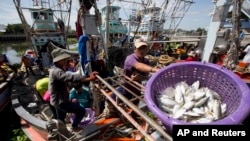Over the past few years, global demand for seafood has far outpaced population growth. The result is overfishing, particularly in easily accessible waters. But as fish stocks become depleted as a result, fishers must travel further out to sea for their catch. Such trips increase expenses like fuel and labor, and some of the less scrupulous operators turn to illegal means of increasing profit.
One avenue toward reducing expenses is reliance on forced labor. “The fishing sector has inherently high risk for human trafficking,” states a new report on Human Trafficking in the Seafood Supply Chain, jointly submitted to the U.S. Congress by the Department of State and the National Oceanic and Atmospheric Administration, or NOAA. “The work is considered hazardous and often relies heavily on a low-skilled, migrant, easily replaced workforce, vulnerable to trafficking.”
This criminal practice is easily hidden because fishing is by its nature isolating. Fishing vessels sometimes spend months, or even years at sea. This makes it nearly impossible for fishers in forced labor situations to escape, or to report ill treatment. Human trafficking victims are frequently subjected to emotional and physical abuse, which sometimes results in death; extremely long work hours; poor living conditions; and underpayment of wages or outright wage theft.
The use of forced labor in the fishing industry is also more likely to occur in politically unstable countries with weak legal protections for civil liberties and workers’ rights, and high levels of corruption, crime, violence, and poverty. The report therefore recommends that the United States implement four steps toward eliminating this scourge. First, the United States must develop a whole of government response to combating human trafficking in the seafood supply chain, both domestically and internationally.
Second, the United States should promote and support efforts to combat human trafficking in countries known to have a problem with forced labor in the fishing industry.
Third, the United States should promote and support global traceability efforts, and engage the fishing industry and NGOs, among other stakeholders.
And finally, these steps should build upon and strengthen State Department’s and NOAA’s existing efforts to address human trafficking in the seafood supply chain.
Combating human trafficking on in the seafood sector is an important human rights and crime issue as well as a U.S. foreign policy priority. The new report is an important step in enhancing and coordinating the United States’ efforts to combat human trafficking in the seafood sector.














